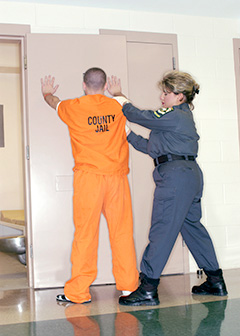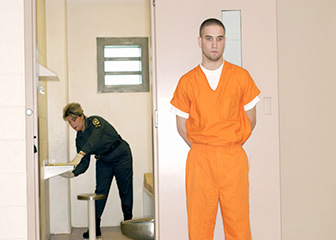How to Become a Correctional Officer About this section

Correctional officers typically attend training at an academy before being assigned to a facility.
Correctional officers go through a training academy and then are assigned to a facility for on-the-job training. Qualifications vary by agency, but all agencies require a high school diploma or equivalent. Some also require some college education or work experience.
Education
Correctional officers must have at least a high school diploma or equivalent. Some state and local corrections agencies require some college credits, but law enforcement or military experience may be substituted for this requirement. For employment in federal prisons, the Federal Bureau of Prisons requires entry-level correctional officers to have at least a bachelor's degree; 3 years of full-time experience in a field providing counseling, assistance, or supervision to individuals; or a combination of the two.
Training
Federal, state, and some local departments of corrections, as well as some private corrections companies, provide training for correctional officers based on guidelines established by the American Correctional Association (ACA). Some states have regional training academies that are available to local agencies. Academy trainees receive instruction in a number of subjects, including institutional policies, regulations, and operations, as well as custody and security procedures.
After formal academy instruction, state and local correctional agencies provide on-the-job training, including training on legal restrictions and interpersonal relations. Many systems also provide training in firearms proficiency and self-defense. Trainees typically receive several weeks or months of training in a job under the supervision of an experienced officer. However, on-the-job training varies widely from agency to agency.
New federal correctional officers must undergo 200 hours of formal training within the first year of employment, including 120 hours of specialized training at the U.S. Federal Bureau of Prisons residential training center. Experienced officers receive annual in-service training to keep up on new developments and procedures.
Correctional officers who are members of prison tactical response teams are trained to respond to disturbances, riots, hostage situations, and other potentially dangerous confrontations. Team members practice disarming prisoners, wielding weapons, and using other tactics to maintain the safety of inmates and officers alike.
Certification
Officers may complete a variety of certifications that provide additional resources for their daily work. These certifications also are a means to further the officers’ careers because they may lead to promotions.
Advancement
Qualified officers may advance to the position of correctional sergeant, who is responsible for maintaining security and directing the activities of other officers. Qualified officers also can be promoted to supervisory or administrative positions, including warden. Officers sometimes transfer to related jobs, such as probation officer, parole officer, or correctional treatment specialist. For more information, see the profile on probation officers and correctional treatment specialists.
Important Qualities
Critical-thinking skills. Correctional officers must determine the best practical approach to solving a problem.
Good judgment. Officers must use both their training and common sense to quickly determine the best course of action and to take necessary steps to achieve a desired outcome.
Interpersonal skills. Correctional officers must be able to interact and effectively communicate with inmates and others to maintain order in correctional facilities and courtrooms.
Negotiation skills. Officers must be able to assist others in resolving differences to avoid conflict.
Physical strength. Correctional officers must have the strength to physically move or subdue inmates.
Self discipline. Correctional officers must control their emotions when confronted with hostile situations.
Writing skills. Officers must be able to understand and learn training materials and write reports regularly.
Correctional officers usually must be at least 18 to 21 years of age, must be a U.S. citizen or permanent resident, and must have no felony convictions. New applicants for federal corrections positions must be appointed before they are 37 years old.







